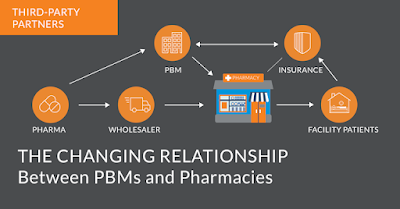By: Marcus J. Hopkins, ADAP Blog Guest Contributor, and Founder & Executive Director of the Appalachian Learning Initiative (APPLI)
Editor's Note: The Blogger platform classifies any use of the word "p(h)armacy" as being a sales promotion. As a result of this erroneous classification, the word and its derivations will be typed using that format in order to avoid being flagged as a sales promotion.
In December 2022, Walmart announced that it would be expanding its Special P(h)armacies of the Community (SPOCs) to support communities with high rates of HIV to include stores in North Brunswick and North Bergen, NJ, Monticello, NY, and Hartford, CT. Those locations joined the initial three locations opened as part of their pilot program.
Since then, Walmart has opened an additional 70 locations, totaling 77 SPOCs located in Colorado, Connecticut, Florida, Georgia, New Jersey, New York, North Carolina, Texas, and Virginia. By the end of 2023, Walmart has promised more than 80 locations across eleven states.
According to their initial press release, Walmart claims that these SPOCs:
will help with all aspects of care, including industry-leading clinical programs, p(h)armacy services provided by HIV-trained p(h)armacists, enhanced care coordination, healthy lifestyle recommendations, and finding emotional support services from our Community Health Workers.
Walmart's SPOCs are located inside of individual p(h)armacies within the stores, ostensibly making the locations convenient to patients and those seeking HIV preventative care.
There are, it should be said, significant benefits to Walmart beyond just the good press. Walmart has enormous opportunities to earn profits by accessing the 340B Drug Pricing Program’s inclusion of HIV medications. According to a 2019 report by Drug Channels, an estimated 25,000 p(h)armacies acted as contract p(h)armacies for hospitals and other covered entities that participate in the 340B program, and six large retail chains—Walgreens, CVS, Walmart, Rite Aid, Kroger, and Albertsons—account for two-thirds of 340B contract p(h)armacy locations.
In recent years, 340B program profits have soared with little to no oversight or enforcement, and we would be remiss if we didn't mention that Walmart stands to earn significant profits from serving as the contract p(h)armacy for People Living with HIV/AIDS (PLWHA), particularly in the markets they've chosen.
Which brings me to the next point:
As Walmart pointed out in its December 2022 statement, roughly 90% of the U.S. population lives within 10 miles of a Walmart location. They also state that these SPOCs provide “…an opportunity to reach people who might not otherwise have access to or seek out HIV care.”
And yet…the locations of these SPOCs are in areas of the country that already receive the bulk of federal funding for HIV testing, services, and treatment. Almost every location is in an urban or suburban population center—areas that often already have p(h)armacies specializing in HIV treatment and care.
It is obvious that these locations were chosen in accordance with the Ending the HIV Epidemic's (EHE) Phase 1 jurisdictions, which resulted in federal HIV funds being directed to the counties and cities where HIV incidence is highest. This methodology is all well and good, but it misses the larger scope of the HIV epidemic and fails to fill the gaps left by this federal funding "plan".
It is curious, then, that Walmart argues that these locations will "…reach people who might not otherwise have access to or seek out HIV care," when those areas are already glutted with services compared to other areas of the country. Looking at Orlando alone, there are 25 providers of care, and four dedicated p(h)macies dedicated to providing services to PLWHA.
If the purpose is to expand access, Walmart would be better suited to open SPOCs in farther-flung areas of those states, where patients are already required to travel more than 30 minutes to access HIV services. Opening a SPOC in Florida’s rural counties, such as Okeechobee, Hardee, DeSoto, Highlands, or Glades, would provide patients living outside of urban areas better access to care and services.
Beyond just the nine current and two potential states where Walmart's SPOCs have or will be opened, there are significant gaps in care and p(h)armacy services in states like Alabama, Kentucky, Mississippi, Tennessee, central and western Virginia, and West Virginia—areas that are largely rural, but have either significant existing populations of PLWHA or face increased risks of HIV transmission either through sexual contact or through Injection Drug Use.
To be clear, I am not being critical of Walmart for expanding services to be inclusive of PLWHA and those seeking preventative services. I am absolutely in favor of a "Yes, And" approach to HIV services provision. The addition of more providers has the potential to provide patients with more choices of where to receive care, and additional opportunities and points of care may allow patients to access services in places that are convenient to them. Additionally, increasing the number of providers has the potential to break HIV care outside of the longstanding monopolistic service provision models that exist both locally and nationally, where patients have been essentially forced to access care, treatment, and supportive services from providers because there hasn’t been anywhere else to go, even if those providers have treated them poorly, engaged in unethical practices, or provided services that aren't culturally competent or sufficient to meet the needs of their patient populations.
That said, Walmart, CVS, and Walgreens haven't really managed to make their locations places where patients—particularly those attempting to access sexual or reproductive healthcare services—feel safe accessing those services or openly discussing concerns with staff p(h)armacists. There’s a distinct lack of personal connection in highly corporate locations, and when you're dealing with fraught issues such as those presented with HIV care and treatment (or other chronic conditions), the last place you want to be if you're having a tough time dealing with issues is in the middle of a large shopping center surrounded by random people trying to find the potato chip aisle.
Overall, however, the expansion of Walmart's SPOC locations seems like a good thing, even if the locations they've chosen don’t really provide services that are novel to those areas. Time will tell whether or not they have any real impact.
Disclaimer: Guest blogs do not necessarily reflect the views of the ADAP Advocacy Association, but rather they provide a neutral platform whereby the author serves to promote open, honest discussion about public health-related issues and updates.









